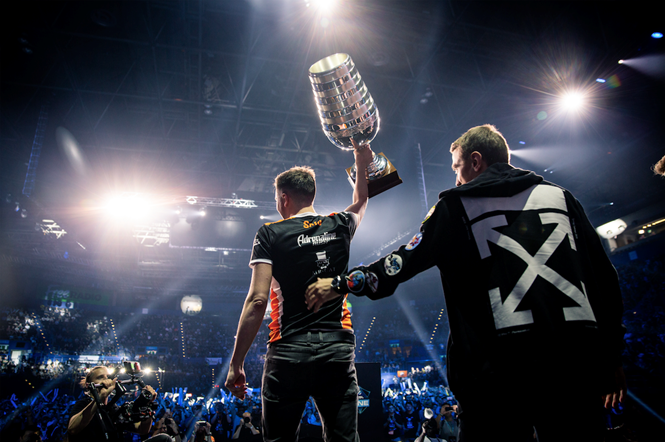State of play

Brand and communications in the gaming industry relies on community engagement, brand partnerships and effective targeting of audiences. Brittany Golob investigates the ways in which gaming is changing and what the future holds for developers, platforms
and communicators
In suburban Los Angeles – and beyond – the 1990s and 2000s were defined by the influx of home gaming. Shifting from the arcade to the PC, the Sega console, the Game Boy, the Tamagotchi, the television screen, gaming took a firm root in culture. The ease of access and proliferation of platforms turned sitting rooms into exotic giant mushroom-filled landscapes and computer rooms into mediaeval castles. It turned car trips across LA’s freeways into racing tracks and school recesses into gaming periods. In some cases, classic arcade games even found their way into the home, with the added benefit of free play.
Now, there are countless ways to play games from the classic console/TV set up to VR headsets to mobile phones. There are countless developers, platforms and brands all vying for a piece of the audience’s time and loyalty. Gaming is an industry that’s changing rapidly, that relies on social clout and branding seemingly equally, and that has mass appeal.
But what is consistent across all those variables is the need to engage the audience. Like the Tamagotchi’s constant pleas for attention – incurring the wrath of teachers contending with a horde of 11 year-olds and their beeping gaming devices. Whether it’s an eSports league, a mobile app or a major brand name, if the gamers don’t like the game, they’ll leave. While brand is important in gaining attention, building a community and launching new products, the quality of the game and its creative is of the utmost importance. “Gamers will decide whether it’s a good product or not,” says Natalie March, account director at London-based creative agency Villain, says. “No matter how good the marketing is, [public opinion] will make or break the success of the game. That’s why there’s this constant challenge to keep improving on the product.”
For that reason, many gaming brands are turning toward community development as a means of maintaining brand loyalty and engagement with their products. “Male and female audiences of all ages and demographics are passionate about games. The challenge for gaming brands is always to find ways to speak to their audience and create a relationship with them,” says March. Villain, which has worked with gaming brands like Assassin’s Creed and Candy Crush, has designed launch experiences and brand communications that helps engage an audience around quality content.
This concept may be why eSports is gaining such popularity. A league based concept, eSports brings live events squarely together with online gaming to great effect. Massive events take place worldwide featuring fans, competitors and brand partners in high-adrenaline settings. Forbes reported on the eSports industry’s revenue growth from $655m to $905m since 2017, a 38% increase. Brand investment will increase by 48% this year, as well. Caroline Pilz, manager of fashion sponsoring and product placement for Daimler AG, said at the Cannes Lions festival that eSports, as a global phenomenon, offers a lot of opportunity for brands, particularly as Mercedes was “one of the first to enter and be a co-creator in the community,” through its partnership with ESL, one of the largest eSports leagues. “You should ask yourself what is the benefit you can bring to the community. The community owns the platform and they really respect if you can add value. It’s still growing; the chances are there to be creative.”
Mercedes is one of many brands who have seen the opportunity and joined forces with eSports leagues, teams or gaming brands to engage with the inbuilt audience of dedicated fans and gamers. Rodrigo Samwell, chief marketing officer of the ESL says this is a key strategy for the league and has helped support its growth. Because of the fast-paced nature of the league, fans can become competitors more easily than in other areas of sports or gaming. “We are connecting directly with consumers to tell an authentic story about where we come from. We try to connect to the audiences as ESL is trying to show that why we are here is to enable everybody to be somebody.”
By partnering with brands, eSports can engage with the brand’s own audiences as well, while providing a richer experience for its community. McLaren, too, has found a unique brand alignment through an entry into eSports. It recently announced the expansion of its eSports platform, the McLaren Shadow Project. The VR programme shadows McLaren’s racing in the real world and is accessible on numerous platforms. The programme helps unite the fan experience and racing community with the McLaren brand. It also helps solidify McLaren’s credentials as a cutting-edge auto sports brand to the gaming community.
Community management is equally important in other areas of gaming, as is accurate targeting of the prospective and existing audience. “The principles are the same with any brand,” March says. “You need to know your audience, and it’s diverse in the gaming world.” She says the different types of game will impact the marketing strategy.
In the world of mobile apps, one of the big challenges is around targeting and engagement of the existing audience. For companies like King, with strong user bases, the preferred strategy is to support new game launches with brand experience events, like those that Villain has worked on. Distribution platforms like Twitch and Steam are highly influential due to their user reviews and social networking aspects, allowing users to become indirect brand ambassadors, or detractors.


For developers, though, understanding the users can help build the brand. Wooga’s hidden object game Pearl’s Peril was examined by behavioural communications agency HeyHuman. Wooga wanted to understand how it could move past the point of market saturation to attract new audiences and get beyond pay-per-click advertising. HeyHuman started its research with a qualitative study of existing users to better understand the role Pearl’s Peril played in their lives. The results were surprising.
“The overriding thing was that they didn’t consider themselves to be gamers,” Jossy Pilgrim, planning director at HeyHuman, says. “They are women who played games. And Pearl’s Peril was just one of many games they played. That was interesting; taking your head out of thinking of them as being gamer-first.” She said one of the other major shifts in mindset was around the reason Pearl’s users played the game. They weren’t playing for the competition or to work through difficult challenges, but to relax, to do something by muscle memory and take a mental break.
Taking those insights to heart, Wooga worked with influencers and Pearl’s existing community to put the game squarely into the ‘me time’ category of entertainment. HeyHuman’s resulting ‘Are you a friend of Pearl?’ campaign repositioned the game as a leisure activity, part of a larger women’s lifestyle conversation. In mobile gaming, Pilgrim says, game cloning is a major issue, thus establishing the ‘need state’ Pearl’s Peril fulfilled enabled it to expand its audience and carve out a brand positioning, for the first time. That shift in brand strategy helped when Wooga launched June’s Journey, another lifestyle game, made for me time, but focusing on a slightly different target audience. Pilgrim adds, “In the mobile gaming world, it’s not just about creating a brand for your game, but also a brand for the developer, so they can start to migrate people across different titles and also in the longer term, create an opportunity to build a better pricing strategy.”
Community engagement has also helped Finnish company HILLA Entertainment Oy establish an audience and build a local brand that is on the verge of global expansion. The Football Triathlon is a Finnish competition that unites football, table football and FIFA football in one tournament for about 100 people every year. Robert Niva, CEO of HILLA Entertainment Oy, says the growth in eSports has helped spur the interest in the Football Triathlon for both players and brand partners.
Niva says the competition has helped to bring new players into eSports and gamers into traditional football. “There are lots of people who think that eSports is not for them and people think that it’s too nerdy a thing, but then, for example, our tournament has brought more interest for the eSports scheme from the people who have been playing only football in the real field, and vice versa,” Niva says. “People who are playing football games with consoles or PCs then get the spark for real football.”
The opportunity is ripe for brands, he says, in cross-platform gaming/sporting events like the Football Triathlon. “Some of the football and ice hockey teams have been opening their own eSports teams and starting to collaborate more and more with brands. Brands learn more and more that there are opportunities in eSports,” he says.
For Wooga, too, branded content and careful targeting of the audience through social media was a key asset to the repositioning of Pearl’s Peril. For the more prominent brands, like Call of Duty or Assassin’s Creed, too, says March, the gaming community can make or break the brand. “Poor quality is punished by an unforgiving audience,” she says. But, that doesn’t mean the big names have the reserve on brand value and the ability to connect with audiences. “There’s always room for the next big thing, even in a market this crowded. This is an audience hungry for the next amazing gaming experience. With clever marketing, a genuinely brilliant game can steal market share from the big hitters,” March adds.
The mobile gaming market took off in earnest with the launch of the iPhone. Now, there’s another cultural shift in gaming looming: the growth of virtual reality gaming. Already developers are turning to full VR or VR elements in games to go after that next big thing. In an always changing market, new technologies have rarely scared loyal gamers off, so the barrier to entry for VR may be less pronounced than for other B2C industries. However, it’s not enough to just launch flashy tech, the success of a game, a developer and a platform relies on the strength of the creative, on the brand’s targeting and on the engagement of the gaming community.













